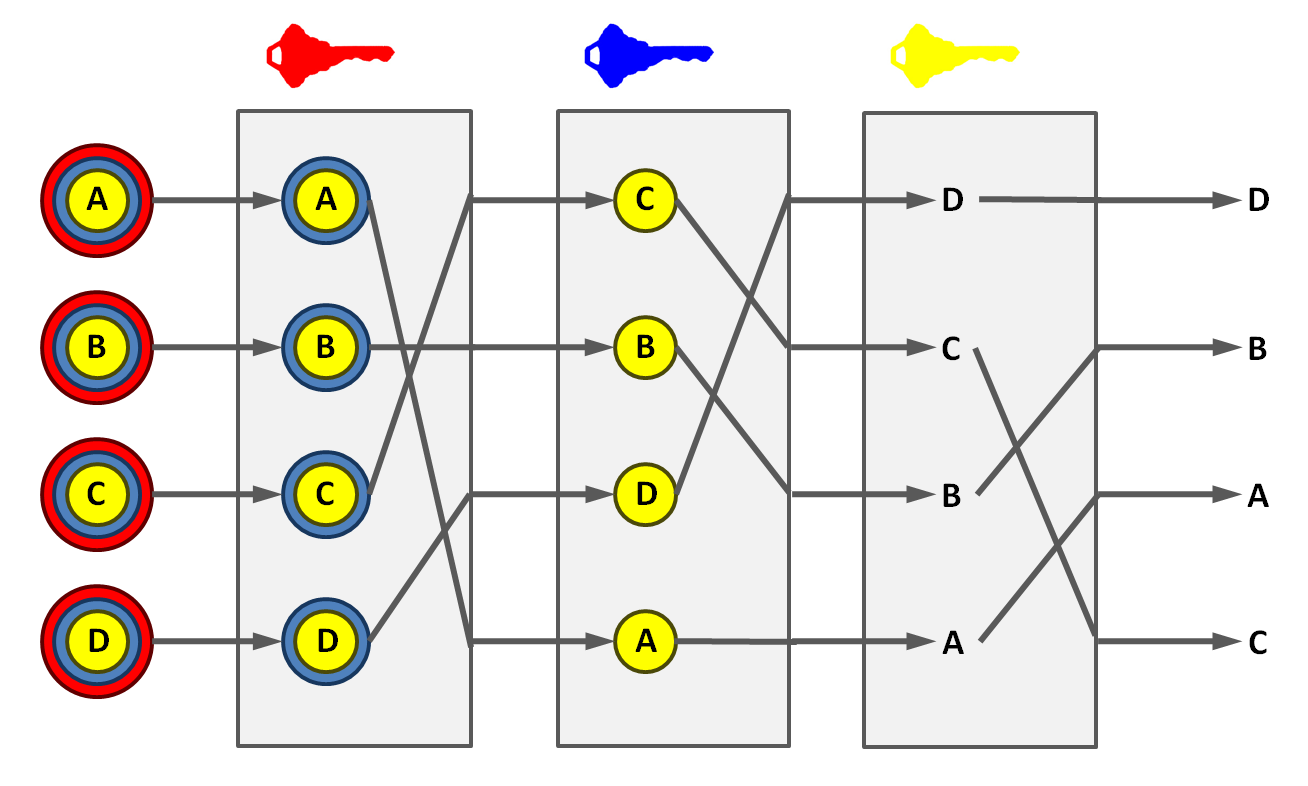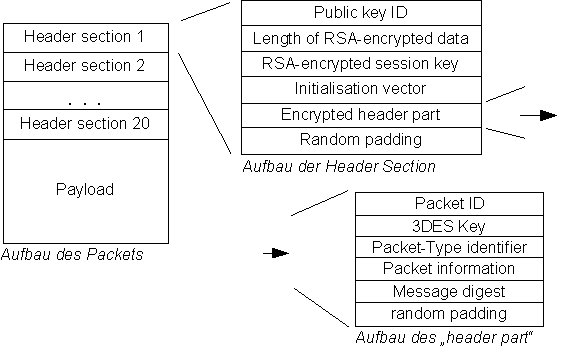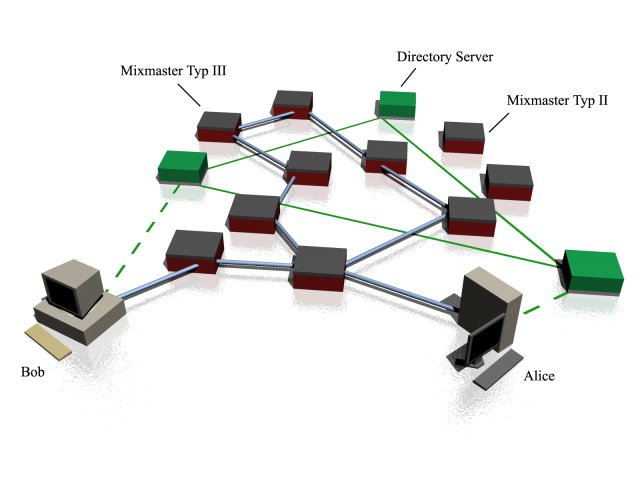Mix networks¶
Mix networks systems and software considered to be used for the pEp MixMailer.
I had used the terms “mix network” and “onion routing” almost interchangeably. In actuality I had fallen into a trap that a fair number of people familiar with the space have fallen into: using those terms without a solid differentiation. This blog post aims to correct that.Mix networks are routing protocols that create hard-to-trace communications by using a chain of proxy servers known as mixes which take in messages from multiple senders, shuffle them, and send them back out in random order to the next destination (possibly another mix node). This breaks the link between the source of the request and the destination, making it harder for eavesdroppers to trace end-to-end communications. Furthermore, mixes only know the node that it immediately received the message from, and the immediate destination to send the shuffled messages to, making the network resistant to malicious mix nodes.
Each message is encrypted to each proxy using public key cryptography; the resulting encryption is layered like a Russian doll (except that each “doll” is of the same size) with the message as the innermost layer. Each proxy server strips off its own layer of encryption to reveal where to send the message next. If all but one of the proxy servers are compromised by the tracer, untraceability can still be achieved against some weaker adversaries.

Pseudonymous remailers¶
A pseudonymous remailer or nym server, as opposed to an anonymous remailer, is an Internet software program designed to allow people to write pseudonymous messages on Usenet newsgroups and send pseudonymous email. Unlike purely anonymous remailers, it assigns its users a user name, and it keeps a database of instructions on how to return messages to the real user. These instructions usually involve the anonymous remailer network itself, thus protecting the true identity of the user.
Nym servers¶
A nym server (short for “pseudonym server”) is a server that provides an untraceable e-mail address, such that neither the nym server operator nor the operators of the remailers involved can discover which nym corresponds to which real identity.
To set up a nym, you create a PGP keypair and submit it to the nym server, along with instructions (called a reply block) to anonymous remailers (such as Cypherpunk or Mixmaster) on how to send a message to your real address. The nym server returns a confirmation through this reply block. You then send a message to the address in the confirmation.
Anonymous remailers¶
An anonymous remailer is a server that receives messages with embedded instructions on where to send them next, and that forwards them without revealing where they originally came from. There are Cypherpunk anonymous remailers, Mixmaster anonymous remailers, and nym servers, among others, which differ in how they work, in the policies they adopt, and in the type of attack on anonymity of e-mail they can (or are intended to) resist
Type I (Cypherpunks)¶
A Cypherpunk remailer sends the message to the recipient, stripping away the sender address on it. One can not answer a message sent via a Cypherpunk remailer. The message sent to the remailer can usually be encrypted, and the remailer will decrypt it and send it to the recipient address hidden inside the encrypted message. In addition, it is possible to chain two or three remailers, so that each remailer can’t know who is sending a message to whom. Cypherpunk remailers do not keep logs of transactions.
More documentation on Cypherpunk remailers:
https://www.iusmentis.com/technology/remailers/index-cpunk.html
https://www.iusmentis.com/technology/remailers/index-anon.html
Last modified: 20 Jun 1998
Properties:
- Transport (between the Cypherpunk remailers): SMTP / POP3
- Format: MIME?
Cons:
- replay attacks
- flooding attacks
- no central directory server, which creates an asymmetry of
- information about the remailers in the network. The not equally distributed knowledge of current servers can be exploited to undermine anonymity and is one of the Cons of the system
- no user friendly clients
- old crypto
- no possibility to replay
- no network diversity/poor anonymity set
- spam

Type II Mixmaster¶
In Mixmaster, the user composes an email to a remailer, which is relayed through each node in the network using SMTP, until it finally arrives at the final recipient. Mixmaster can only send emails one way. An email is sent anonymously to an individual, but for them to be able to respond, a reply address must be included in the body of the email. Also, Mixmaster remailers require the use of a computer program to write messages. Such programs are not supplied as a standard part of most operating systems or mail management systems.
Mixmaster Protocol Version 2, December 29, 2004:
Cryptographic Algorithms:
The asymmetric encryption mechanism is RSA with 1024 bit RSA keys and the PKCS #[MixOnion] v1.5 (RSAES-PKCS1-v1_5) padding format [Nymtech]. The symmetric encryption mechanism is EDE 3DES with cipher block chaining (24-byte key, 8-byte initialization vector). MD5 is used as the message digest algorithm.
Packet format:
The header sections (except for the first one) and the packet body are encrypted with symmetric session keys
Properties:
- topology: cascade (no scalability, then poor anonymity set)
- mixing strategy: batch and reorder (unpredictable delays) Have an
- adjustable size message pool in which incoming packets are collected and re-sorted randomly before being forwarded.
- Key/node discovery: pinger
- Transport: SMTP
- Format: MIME?
- Packets: all packets are the same size.
- Packet format:
- Cover traffic: can send dummy packages
- Compatible with Cypherpunk messages.
Pros:
- third party untraceability between sender and receiver
- resistant to timing correlation attacks
- support replies or anonymous recipients (not resistant to replay
- attacks)
Cons:
- not resistant to active attacks, eg. dropping packets and causing denial of service
- not resistant to replay attacks
- no central directory server (network partitioning)
- no user friendly clients
- old crypto
- no replies
- no network diversity/poor anonymity set
- spam
Packet structure:


Type III Mixminion¶
A Mixminion remailer attempts to address the following challenges in Mixmaster remailers: replies, forward anonymity, replay prevention and key rotation, exit policies, integrated directory servers and dummy traffic. They are currently available for the Linux and Windows platforms. Some implementations are open source.Mixminion supports Single-Use Reply Blocks (or SURBs) to allow anonymous recipients. A SURB encodes a half-path to a recipient, so that each mix in the sequence can unwrap a single layer of the path, and encrypt the message for the recipient. When the message reaches the recipient, the recipient can decode the message and learn which SURB was used to send it; the sender does not know which recipient has received the anonymous message.
Properties:
- Transport: TLS instead of SMTP.
- Key/node discovery: directory servers or pinger
- Key rotation:
- Up to 32 instead of 20 hops.
- Packet format: Sphinx
- Compatible with Cypherpunk and Mixmaster messages.
Pros:
- directory servers (no partitioning)
- Indistinguishable between forward and reply messages.
- Forward secrecy by using TLS
Cons:
- no user friendly clients
- old crypto
- no network diversity
- spam

Remailer vulnerabilities¶
Katzenpost¶
Properties:
- topology: stratified (scales, better anonymity set)
- mixing strategy: stop and go (predictable relays)
- packet format: Sphinx
- it has Providers as entry point that require authentication,
- therefore it is needed to first
- sender needs to know the receiver Provider (no receiver anonymity?)
Pros:
- third party untraceability between sender and receiver
- better scalability, therefore better network diversity/anonymity set
- predictable delays
- it could be possible to use the mixnet to send Email only between two
- organizations that “trust” each other without SPF to have 3rd party unlinkability
Cons:
- License is AGPL v3, not compatible with xGPL v2, which means it can’t
- be part of iOS. katzenpost license can not be changed cause one of their authors. We’d need to rewrite katzenpost client and mailproxy to use it in iOS
- not designed to run with Email messages there is a mailproxy, but
- katzenpost devs are unhappy with the mail proxy
- no production network atm
- sender needs to authenticate with a Provider
- sender needs to know the receiver Provider (no sender anonymity)
- for the providers to be able to send Email to any destination, they
- need to use SPF, therefore no sender anonymity
- different Email traffic patterns (eg. Deltachat) would need different
- delay parameters